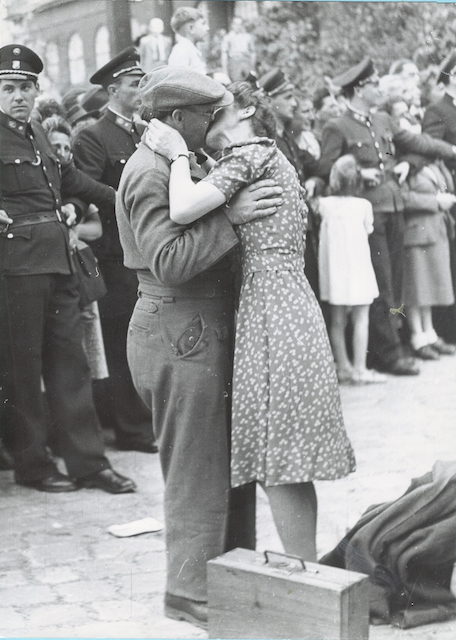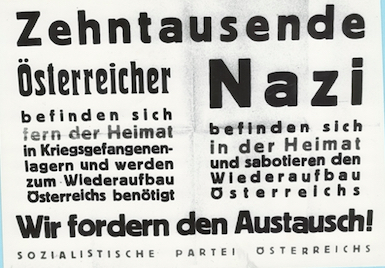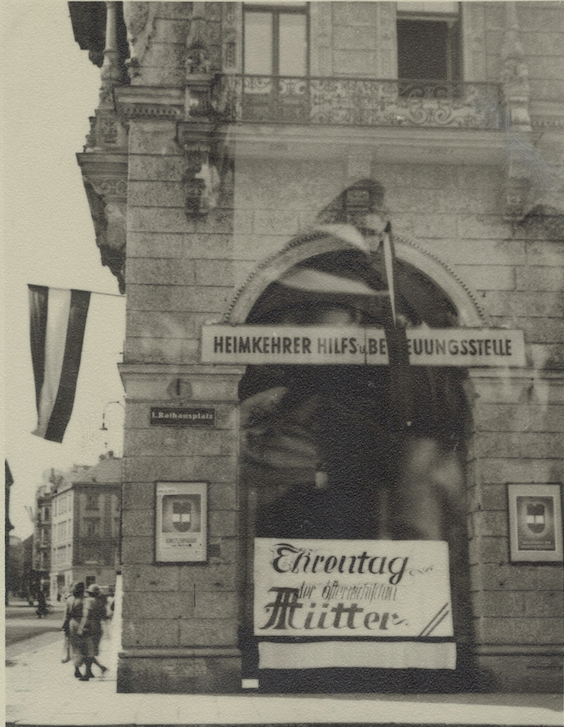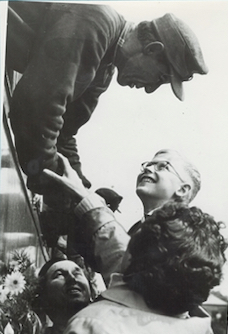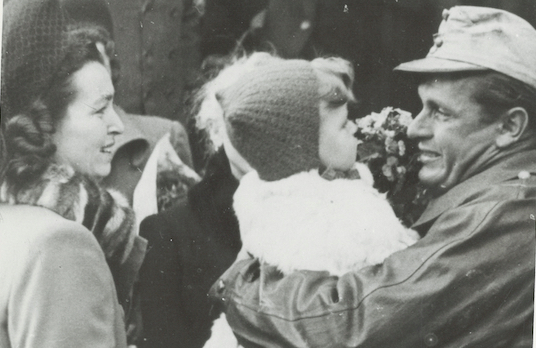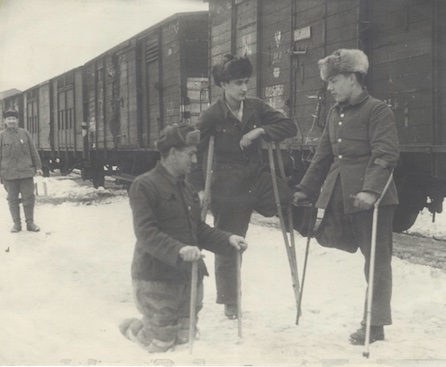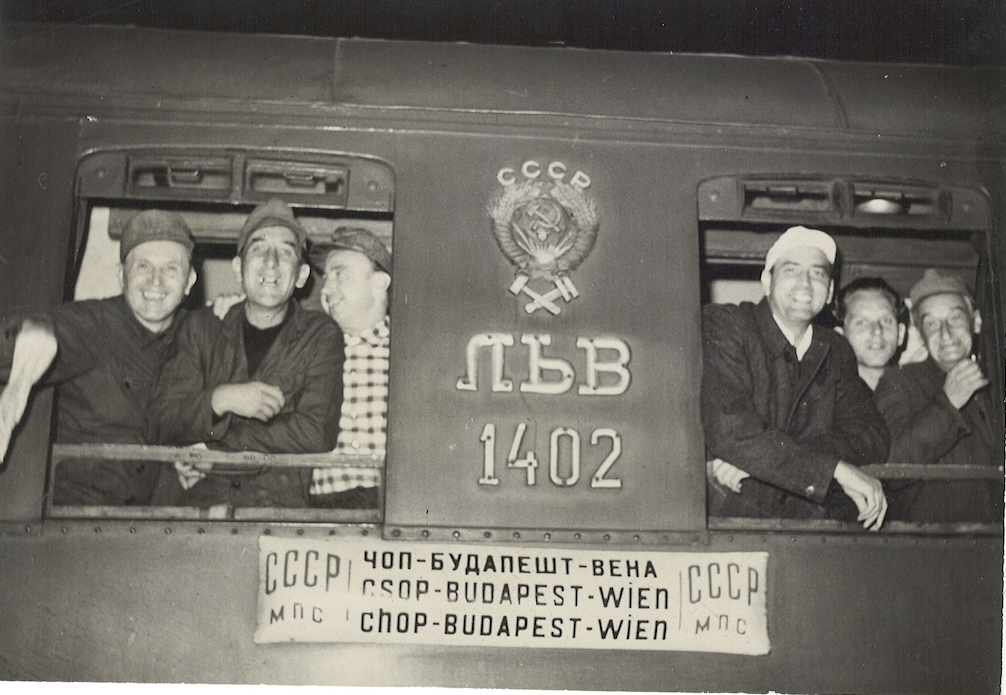5.1 Entnazifizierung
Die auf den ersten Blick eventuell widersprüchliche Kombination der beiden Themenbereiche „Heimkehrer“ und „Entnazifizierung“ täuscht, denn bereits beim groben Sichten des relevanten Quellenmaterials haben sich Gemeinsamkeiten ergeben, die durchaus eine gemeinsame Betrachtung zulassen.
Als Begründung mag die Tatsache gelten, das beide Gruppen nach ausschließlich realpolitischen und parteitaktischen Erwägungen behandelt wurden. In beiden Fällen wurden Personengruppen angesprochen, die nicht von Anfang an und oft erst nach Jahren emanzipiert und somit aus parteipolitischen Sicht nur eingeschränkt rekrutierbar waren.
Wie auch schon an anderer Stelle hervorgehoben, ist die Quellenrecherche nicht nur auf das Karl-Renner-Institut und das Karl-von-Vogelsang-Institut beschränkt gewesen. Dennoch ist die Dokumentation zum behandelten Kapitel hauptsächlich auf bislang unbekannte bzw. unausgewertete Korrespondenz- und Protokollmaterialien aus den Parteiarchiven von SPÖ und ÖVP aufgebaut.
Die chronologische Darstellung der historischen Abläufe bedingt, dass speziell politische Absichtserklärungen und Haltungen der KPÖ (insbesondere bis zu ihrem Ausscheiden aus der Regierung 1947), die in den koalitionären Regierungs- und Parteimaterialien beinhaltet sind, Berücksichtigung finden.
Ein weiteres Kriterium zur Quellenaufarbeitung liegt in der kontinuierlichen Veränderung der parteilichen Standpunkte und der psychologischen Annäherung der beiden Bereiche an den Status eines „politischen Opfers“. Beide Lager, d.h. ehemalige Nationalsozialisten sowie Heimkehrer, waren so mancher Kritik ausgesetzt, andererseits als Stimmenpotential intensiv umworben.
Die Veränderung in der politischen Beurteilung der Nationalsozialistenfrage begann schon in den ersten Nachkriegsmonaten das Verhalten der Parteien zueinander nachhaltig zu prägen.
Das „Verbotsgesetz“ vom 8. Mai 1945 (Verfassungsgesetz über das Verbot der NSDAP) konnte bereits kurze Zeit nach Inkrafttreten nicht mehr als einigendes Band der „Drei demokratischen Parteien“ angesehen werden. Ganz im Gegenteil - Interpretationsfreiräume hinsichtlich Sühnefolgen und genereller Registrierungspflicht verschlechterten zusehends den Umgangston und das Arbeitsklima in der Koalition.
Für ÖVP-Generalsekretär Felix Hurdes war somit auch die ergänzende Durchführungsverordnung zum Verbotsgesetz, respektive deren Umsetzung, ein Gradmesser für die gedeihliche Zusammenarbeit in der Regierung.
Die Forderung von Hurdes nach alleiniger Rechtshoheit zeigt ganz klar die Besorgnis über allzu große Einflußnahme und Bevormundung durch alliierte Stellen:
„... es ist nicht gewährleistet, daß die Entscheidung über Gesuche (Nachsicht von der Registrierung) in der Hand der drei politischen Parteien ist.“ (Dokument c)
Die von Hurdes in dem Schreiben an Schärf (SPÖ) und Koplenig (KPÖ) vom 26. Juni 1945 verlangte Dezentralisierung der Beurteilungsstellen (Bezirkshauptmann) konnte in dieser Form nicht realisiert werden.
Trotzdem zeigt sein Vorschlag zur juristischen Angleichung des Parteigesetzes der ÖVP das Bekenntnis der ÖVP zur Unterscheidung von „schlechten“ und „guten“ Nationalsozialisten:
„( ) in überzeugender Weise klarmachen kann, dass er (Anwärter und Mitglied; Red. ) seine Stellung in Partei oder Wehrverbänden nicht missbraucht hat .. „ (Dokument 1)
Die Situation der SPÖ stellte sich im Zeitraum Frühling/ Sommer 1945 anders dar als jene der ÖVP und ihrer bei SP-KP entscheidende Entsprechend ihres ideologischem Grundkonsenses antifaschistischen· Tradition war das NS-Problem bei Kontaktgesprächen ein Thema, dem von beiden Seiten Bedeutung beigemessen wurde.
Bei der Sitzung des Kontaktkomitees zwischen KPÖ und SPÖ am 1945 wurde die Entnazifizierung eingehend besprochen am 10. Juli
„( ... ) Gen. Führenberg (Friedl Fürnberg: Red.) stellt fest, dass die KPÖ sich mit der Forderung: NSDAP-Mitglieder und Anwärter nur aus den leitenden Stellen zu entfernen, nicht durchwegs zufrieden geben könne. ( ... ) An Stelle der NSDAP-Funktionäre müssen junge, zuverlässliche Antifaschisten gesetzt werden. Die SPÖ hält den KP-Vertretern vor, dass sie unter den NSDAP-Funktionären werben und damit den
Nationalsozialisten, die auch nach ihrer Meinung ausgerottet werden müssen, die Funktion des Züglein an der Waage geben.( ... )“ (Dokument 2)
Trotzdem galt der Leitsatz, wonach eine kompromissfähige Dreiparteieneinigung stets einer direkten Einflussnahme der alliierten Elemente vorzuziehen war.
Wie gering allerdings dieser „Kompromiss-Spielraum“ war, zeigen die innerparteilichen Umdenkprozesse.
Die Frage nach Schuld, Sühne und Wiedergutmachung hatten sich mittelfristig jenen nach Verwendbarkeit und politischen Integration unterzuordnen.
Kurzfristig (1945/46) trug die Nationalsozialisten-Gesetzgebung jedoch das Stigma der Vergeltung.
Bei der Parteienverhandlung zwischen ÖVP, SPÖ und KPÖ über die Grundzüge der Entnazifizierung vom 22. März 1946 war noch immer keine merkliche Entlastung früherer Nationalsozialisten spürbar. Nach der zügigen Durchführung des Opferfürsorgegesetzes dominierten die Sühnefolgen für registrierungspflichtige Nationalsozialisten: (Lohnsteuererhöhungen, progressive Vermögensabgabe, pensionslose Entlassung aus dem öffentlichen Dienst, Ausschluß von der Bekleidung eines leitenden Postens, Ausschluß vom Wahlrecht, Berufsverbote)
Die zusätzliche Differenzierung zwischen „minderbelasteten“ sogenannte „belasteten“ und Personen öffnete einer oft willkürlichen Interpretationsvielfalt und in späterer Folge einer intensiven Interventionstätigkeit Tür und Tor.
Eine interessante Sonderstellung nahm die Entnazifizierung bei den Eisenbahnen ein. In manchen Bezirken waren die SPÖ und ÖVP-Vertreter richtiggehend erstaunt, wie hoch der Anteil von Registrierungspflichtigen war.
Die ÖVP vermutete bereits im Frühjahr 1946, daß die SPÖ um die Unterstützung und Mitgliedschaft vorbelasteter Eisenbahner wirbt, wie einer Gedächtnisnotiz vom 3. Juni 1946 zu entnehmen ist:
„ ( ... ) Daneben läuft eine Aktion (der SPÖ; Red.), die die Wieder-indienststellung einer Reihe prominenter Nationalsozialisten zum Ziel hat. ( ... ) „(Dokument 7)
Das Verbotsgesetz, das von manchen mitgestaltenden Politikern als „Vergeltungsgesetz“ tituliert wurde, führte aber auch dazu, dass eine ideologische Auseinandersetzung mit dem Nationalsozialismus erschwert bzw. sogar verhindert wurde: Zum einem fühlten sich sühnepflichtige Personen zusehends in einer Märtyrerrolle und zum anderen war nur zu klar, dass de-facto, wenn auch nicht de-jure, ein Schlussstrich unter die NS¬Epoche gezogen werden sollte.
Die gesetzgebenden Instanzen, innen- und außenpolitisch relevante Gremien der Jahre 1945 bis 1947, standen noch unmittelbar unter dem direkten Eindruck nationalsozialistischer Greuel und Willkürherrschaft.
Doch nicht bloß die politische Pragmatik zielte auf eine Abschwächung der Nationalsozialisten-Gesetzgebung ab, auch der Verweis auf offensichtlich nachsichtige alliierte Positionen tat ein übriges. Der vielzitierte Befehl Nr. 1 des russischen Militärkommandanten tat den einfachen Mitgliedern der NSDAP kund, dass sie für die Zugehörigkeit zu dieser Partei nicht verfolgt
werden, wenn sie sich der Roten Armee gegenüber loyal verhalten. Auch die Potsdamer Beschlüsse vom 2. August 1945 teilten die Mitglieder der NSDAP in aktive und bloß formelle Mitglieder ein und verlangten lediglich die Entfernung der aktiven, also der führenden Mitglieder, aus ihren Funktionen in Staat und Wirtschaft .
Es wäre allerdings weit gefehlt den Standpunkt einer politischen Partei zur Entnazifizierung 1945 bis 1949 als unumstößlich und innerparteilich unumstritten zu bezeichnen. Während die SPÖ im März 1947 die Streichung von Nationalsozialisten aus dem Register für die den drei Parteien nahestehenden Personen in beschränkter Zahl forcierte, hielt die ÖVP ein Modell ähnlich dem der Staatsbürgerschaftsansuchen, entgegen.
In einer Besprechung über das Nationalsozialisten-Gesetz führte Staatssekretär Graf am 21. März 1947 aus:
„( ... ) Wir wollen zu einer einheitlichen Ausrichung kommen. Diese ist notwendig, weil die Entscheidung für die als „besonders“ bezeichneten Fälle in Wien fallen wird. Wir wollen erreichen, daß das Nationalsozialisten-Gesetz gegenüber der Gruppe der Minderbelaseten so durchgeführt wird, daß es tragbar ist. ( ... )“ (Dokument 9)
Demnach sollten jene Ansuchen um Sühnenachlaß positiv bewertet werden, an denen aufgrund der Qualifizierung besonders Interesse besteht.
So sollten nach der ÖVP-Diktion die Ansuchen von Nationalsozialisten in 3 Gruppen geteilt werden:
a) Ansuchen, die im besonderen Interesse liegen und möglichst schnell zu erledigen sind.
b) Ansuchen, denen ein gewisses, wenn auch beschränktes Interesse zukommt.
c) Alle übrigen Ansuchen, welche der normalen Erledigung zugeführt werden (Dokument 9)
Zu den selbst in den gesetzgebenden Körperschaften als hart bezeichnete Sühnefolgen, trat eine noch härtere Anwendung des Gesetzes.
Dass diese Nationalsozialisten-Gesetzgebung 1945 bis 1947, also lange vor der „NS-Amnestie“ 1957 aus taktische und emotionalen Gründen als Ballast empfunden wurde, beweist unter anderem auch die Tatsache, dass seit 1947 in den Wahlprogrammen aller politischen Parteien immer wieder das Versprechen nach Aufhebung der Nationalsozialisten-Gesetzgebung zu finden war.
Auch die Verwaltung konnte sich mit der anfänglichen Form des Verbotsgesetzes nicht befriedigend identifizieren, und legte daher 194 7 bis 1953 dem Parlament Abänderungsvorschläge (im Wege von Regierungvorlagen) zur Behandlung vor.
Bei Durchsicht der vorhandenen Primärquellen erschien die Enteignung von Kleingärten und Möbel - beschränkt auf den Wiener Raum - als besonders willkürlicher Aspekt der Nationalsozialisten-Gesetzgebung, der unter dem Eindruck sowjetischer Enteignungspolitik in den Nachbarstaaten, beim überwiegenden Teil der Bevölkerung auf Unverständnis und Protest stieß. Es war dies eine Wegnahme der Klein- und Schrebergärten, die vor 1945 von Nationalsozialisten rechtmäßig gepachtet, gekauft oder durch die Mitgliedschaft bei einem Kleingartenverein oder gar Genossenschaft erworben wurden. Von den diesbezüglichen Bestimmungen des Nationalsozialisten-Gesetzes waren rund 6000 Wiener Familien betroffen.
Durch das Nationalsozialisten-Gesetz in der Fassung 1947 wurde die damalige willkürliche Enteignung nachträglich gutgeheißen.
Längere Debatten gab es ebenfalls über die Bestimmungen des Wirtschaftssäuberungsgesetzes, aufgrund dessen belastete Privatangestellte nicht mehr ihren Beruf nachgehen konnten.
Diese Härten trafen somit nicht nur einzelne, sondern beeinträchtigte mit dieser Maßnahme auch die ganze volkswirtschaftliche Aufbauphase.
Genau diese Aufbauphase wiederum aber war erklärtes Ziel der Politik und alleiniger Gradmesser der Parteien über Erfolg oder Misserfolg. Dieser politische Balanceakt der Parteien zwischen „hartem“ und „weichem“ Kurs, zwischen den unterschiedlichen Ansprüchen und Interessen ihrer (zukünftigen) Wählerschaft dokumentieren nachfolgende Korrespondenzen, die die Jahre 1947 bis 1949 anhand veränderter politischer Betrachtungen inhaltlich unterlegen. (Dokument 10) und (Dokument 11)
Komplementäre Quellenfunde in den ÖVP- und SPÖ-Parteiarchiven beweisen die inhaltliche Austauschbarkeit in der Behandlung des NS-Gesetzes durch die Parteien.
Die NS-Referate waren seit ihrer Installation mit „Härtefällen“, begründeter und unbegründeter Art, beschäftigt, so dass durch diese Interventionspolitik die Referate zu potentiellen Rekrutierungsstellen neuer Mitglieder wurden.
Nadine Paunovic, die ÖVP-Bundesleiterin des Österreichischen Frauenbundes und als solche auch mit Fällen zur Nationalsozialisten-Gesetzgebung konfrontiert, führte in einem Schreiben an Bundesminister Felix Hurdes vom 27. Juni 1947 über die „wachsende Präpotenz der Nazikreise“ Klage:
„ .... .ich habe für alle politisch-taktischen Erwägungen und auch für die prinzipiellen Menschlichkeitsgründe das allerhöchste Verständnis. Aber ..... jene Parteigenossen, die aus Feigheit oder Ignoranz, Mitglieder der NSDAP geworden sind, sind durchaus unsere Leute und sind dankbar, wenn man ihnen gut und freundlich entgegen kommt. Ein anderer Teil fordert, stellt sich als Märtyrer hin, und scheut sich nicht seine nazistischen Gedanken betont vorzubringen ..... Oft klagen Personen, die vor dem Nichts stehen: Es tut uns leid, daß wir keine Nazis sind, aber so kümmert sich niemand um uns.( .... )“ (Dokument 10)
Diesem Unbehagen zum Trotz war die Minderbelasteten-Amnestie, die vom Nationalrat am 28. Mai 1948 beschlossen wurde, ein weiterer Schritt in Richtung innenpolitischer Befriedung und Normalisierung in Österreich. Somit verblieben noch an die 43.000 Belastete, die bei realistischer und unvoreingenommener Betrachtung den eigentlichen Kern der früheren NSBewegung in Österreich darstellten.
Die Liste der ab 1948 einsetzenden „Amnestien“ (Minderbelasteten-Amnestie, Belasteten-Amnestie, Wahlschwindel-Amnestie-für falsche Angaben bei der Nationalratswahl 1945-, Streichungsamnestie, Spätheimkehreramnestie, etc.) stand vom Umfang her den vorangegangenen Sühnemaßnahmen in nichts nach.
Hervorzuheben erscheint auf dem Weg zur kompletten „NS-Amnestie 1957“ vor allem die sogenannte „Belasteten-Amnestie“. Bereits ab Anfang 1949 beschäftigten sich die österreichischen Parlamentarier mit diesem Thema, die etwa 30.000 oder 3/4 der Belasteten in Zukunft von den Sühnefolgen ausnehmen sollte. Das Aufweichen in der Nationalsozialisten-Gesetzgebung offenbarte sich schon in der Debatte über das B-VG über die vorzeitige Beendigung der vorgesehenen Sühnefolge für minderbelastete Personen.
Am 21. April 1948 sagte Nationalrat Alfons Gorbach:
„Wenn wir heute auch hier die Amnestie der Minderbelasteten beraten, so möchte ich die Belasteten nicht ausschalten. Wir werden trachten müssen, der Sorgenlast unserer Tage Rechnung zu tragen, um den Typ belasteter Personen zu verringern, anstatt ihn durch juridische Doktrinen in Unabänderlichkeit erstarren zu lassen“. (Stenographische Protokolle, 21. März 1948)
Der Weg schien frei, um mit der Belasteten-Amnestie 1949 noch einen Schritt weiter zu gehen.
Doch der Initiative der ÖVP folgte der Koalitionspartner SPÖ nicht, mit der Begründung, die Alliierten nicht vor dem Kopf zu stoßen oder gar zu Gegenmaßnahmen zu reizen. Erst 1952 wurde eine gemeinsame großkoalitionäre Vorgangsweise zur „Belasteten-Amnestie“ gefunden. Soweit war das politische Handeln von parteitaktischen Überlegungen geprägt.
Nationalrat Gorbach vermutete in einem Schreiben an Figl vom 20. Juli 1949:
„ .... die Sozialisten haben die Regierungsvorlage über die BelastetenAmnestie zu Fall gebracht, um uns um den Erfolg unseres Einsatzes für die Lösung des NS-Problems zu bringen Vorkehrungen müssen getroffen werden ..... um unseren Bestrebungen in den Kreisen ehemaliger Nationalsozialisten stärksten Widerhall zu verschaffen.( .. )“. (Dokument 11)
Die Einstellung der Parteien zur Demokratie und damit zum wichtigsten demokratischen Instrument, nämlich Wahlen zu gewinnen, rechtfertigte ausschließlich das Werben um Stimmen ehemaliger Nationalsozialisten. Alle Parteien zeigten von 1945 an die Einsicht, Maßnahmen zur Entnazifizierung zu setzen, ebenso wie sie einen zeitlich begrenzten Rahmen dafür sahen.
5.2 Heimkehrer
Der Bereich Heimkehrer muß konsequenterweise umfassend gespannt werden:
Ausgesiedelte und (ehemalige) Volksdeutsche sind ebenso in dieser Arbeit, erfaßt wie die Kriegsheimkehrer. „Displaced Persons (DP)“ fanden in dieser Edition keine Berücksichtigung.
Analog zum vorangegangenem Kapitelteil war der Lösungsansatz, d.h. das Erfassen von großen Bevölkerungsmassen für ein Stabilisieren der drei neuen demokratischen Parteien von nachhaltiger Bedeutung: Ein Vernachlässigen bzw. Überbewerten von Entnazifizierung und der Heimkehrerfrage sollte von Anfang an nicht schuld sein am mäßigen Erfolg der Parteien. Dementsprechend engagiert wirkten die Parteistellen in der Öffentlichkeit.
Die Betreuung von direkt aus der Gefangenschaft gekommener Männer, die Vermittlung von Wohnraum und Arbeit vor den „Augen“ von Angehörigen und unmittelbar Betroffenen entsprach ganz und gar dem Verständnis der Parteien von der „Stunde Null“.
Alle drei Parteien sahen die Tätigkeit der Heimkehrerstellen als eine ausgesprochene Propagandatätigkeit an.
Vor allem die „Heimkehrerhilfe“ der ÖVP (Heimkehrer-Hilfs- und Betreuungsstelle = HHB) und das sozialistische „Heimkehrerreferat“ waren von ihrer Struktur und Anlage her neben materieller Hilfe auf politische Indoktrination ausgerichtet. Wegen organisatorischer Vorteile, aber auch wegen der zügiger entwickelter Bereitschaft sich des Heimkehrerproblems anzunehmen, war die ÖVP bereits unmittelbar nach der Parteigründung offensiv geworden, während seitens der Sozialistischen Partei die Heimkehrerhilfe anfangs ausschließlich auf Einzelinitiativen beschränkt blieb.
Der große Unterschied zwischen den beiden Parteien lag weiters in der Bundesländertätigkeit. Die SPÖ zog es bis Frühjahr 1946 vor, beinahe einzig und allein in Wien einen Betreuungsapparat zu installieren. Dem gegenüber gelang es der ÖVP ein über das ganze Bundesgebiet erstreckendes Netz der HHB zu schaffen. Erst auf einer Parteivorstandssitzung der SPÖ am 13. Mai 1946 stellte Bundesminister Helmer den Antrag, den Wirkungsbereich des in Wien gebildeten Heimkehrerkomitees auf ganz Österreich auszudehnen. Verweise auf einen zeitlichen und methodischen Vorsprung bei ÖVP-Aktionen sind jedoch schon in Monate vorher datierten SPÖ-Quellen festzustellen. Der Grund für diese Passivität der SPÖ ist auch in taktischen Überlegungen zu erkennen.
Das parteiinterne Heimkehrerreferat sprach sich noch Ende 1946 (Schreiben an den Parteivorstand vom 11. Dezember 1946) gegen die Schaffung einer eigenen Heimkehrerbewegung aus:
„( ... ) Wir sehen die Tätigkeit des Heimkehrerreferats als eine ausgesprochene Propagandatätigkeit für die Partei an. Wir lehnen aus sehr wichtigen Gründen die Schaffung einer eigenen Heimkehrerbewegung ab. Unsere Arbeit ist daher Bestandteil der Partei. ( ... ) „ (Dokument 12)
Erwägungen in diese Richtung könnten die Parteispitze somit bewogen haben, ihre eigenen Stellen nicht mit der letzten Konsequenz zu unterstützen.
Die auch im Bereich Entnazifizierung zu berücksichtigenden Faktoren, wie Erweiterung des Parteienspektrums und Gründung von parteiexternen Parallelorganisationen mit dem Ziel der Schwächung von SPÖ bzw. ÖVP, kamen auch hier zum Tragen.
Eingliederung in den Bundesländern
Für die ÖVP, bei der auch in der Heimkehrerfrage ihr föderalistisches Prinzip nachvollziehbar ist, kann das Beispiel des Bundeslandes Salzburg als repräsentativ gelten:
Bereits am 28. September 1945 erging von der HHB der ÖVP im Salzburger Chiemseehof ein Rundschreiben an alle Ortsgruppen und Bürgermeister, in welchem die Gründung der Hilfsstelle bekanntgegeben wurde.
In diesem Schreiben wurde gebeten, in jeder Ortsgruppe einen Vertrauensmann unter den Heimkehrern zu bestellen, dessen Aufgabe es ist, die Interessen der Heimkehrer bei der Gemeinde zu vertreten, Missstände an die Hilfsstelle zu melden.
In den Landesparteileitung Salzburg wurde Monate hindurch eine große Suchaktion nach Kriegsgefangenen und Vermissten durchgeführt. Die eingebrachten Anträge wurden an den Landeskommissar für Kriegsgefangenen-Rückführung zur weiteren Bearbeitung weitergeleitet.
Die Landesleitung sprach des öfteren bei der US-Militärregierung wegen Auflösung der österreichischen Kriegsgefangenenlager im Lande Salzburg vor und hatte damit auch teilweise Erfolg. Ein Ansuchen um Überlassung von Baracken zur Errichtung eines Heimkehrerlagers unter Leitung der ÖVP wurde allerdings abschlägig beschieden.
Es dauerte bloß bis Anfang 1946 bis Kritik am Ablauf und der Ausführung dieses Hilfsmodells laut wurde. Zahlreiche Schreiben dürften überhaupt nicht in den Gemeinden angenommen oder nicht beachtet worden sein.
Als besonderer Kritikpunkt erwies sich die Tatsache, dass bekannte NSParteigenossen oder Gliederungsangehörige in wohlgeordneten Verhältnissen lebten und sowohl Wohnungen als auch Arbeitsplätze hatten, während Heimkehrer und Kriegsversehrte oft keine Beschäftigung etc. finden konnten. Ein Grund dafür bestand in der organisatorischen Aufsplitterung der sozialen Hilfsangebote und der noch mangelhaft ausgeprägten zentralen (Bundes-) Leitung.
Das Nebeneinanderbestehen von Invalidenverbänden, ÖVP-Kinderrettungswerk, Sozialen Hilfswerk, Amerikanische Bekleidungshilfe, Schweizer Hilfe und Heimkehrerfeste, die alle auch der Heimkehrerhilfe zu Gute kommen sollten, führten in den Monaten September 1945 bis Juli 1946 zu organisatorischen Problemen. Aufgrund von Parteienübereinkommen war eine zentrale Informationsstelle für Heimkehrer ab Frühjahr 1946 bei allen Landesregierungen eingerichtet worden. So stellte z. B. in Oberösterreich noch vor der ausdrücklichen Weisung aus Wien (Staatssekretär Ferdinand Graf) auf Anordnung Landeshauptmannes Gleißner die ÖVP ihren Heimkehrerdienst ein und übergab sämtliche Unterlagen nach Bildung der offiziellen Behörde der Landesregierung in Linz. Mitausschlaggebend für diese Entscheidung war zweifellos die Absicht der ÖVP, die Heimkehrerstelle, die sich finanziell selbst erhielt, nicht zu einem wirtschaftlichen Risiko für die Partei werden zu lassen.
Das Beispiel Salzburg führt auch den zahlenmäßigen Umfang vor Augen:
Von Oktober 1945 bis Jänner 1946 befanden sich (einschließlich der Durchreisenden) 1753 Heimkehrer in der Obhut der ÖVP-Heimkehrerhilfsstellen. Davon wurden über 350 Personen in beruflich gesicherte Positionen übernommen. Der Schnitt von ca. 250 bis 300 neu in den Arbeitsprozess eingegliederten Heimkehrern entsprach auch in den übrigen Bundesländern in etwa den Erfolgen der ÖVP-Heimkehrerhilfsstellen.
In allen Landeshauptstädten und größeren Gemeinden wurden Abendkurse für Heimkehrer in verschiedenen Unterrichtsfächern zwecks beruflicher Weiterbildung bzw. infolge Invalidität eine entsprechende Umschulung abgehalten.
Die Haltung der Bundes-ÖVP nach der ersten Länder-Konferenz im Herbst 1945 zu dieser Thematik drückt die Bedeutung aus, die dieser Frage von der Partei beigemessen wurde.
Sehr zum Ärger der SPÖ, wo sich Bundesminister Helmer als Chef des Innenressorts mit Ansprüchen meldete, war es Bundeskanzler Figl, der beinahe sämtliche Agenden, der Kriegsgefangener und Heimkehrer in seinen Aufgabenbereich einbezog. Bei dem Bedarf großer finanzieller Beträge, die zur Abwicklung dieser Heimkehrerhilfe notwendig waren (das ÖVP-Referat für Heimkehrerhilfe wies bis Frühjahr 1946 insgesamt 3,5 Millionen Schilling Aufwand aus) sollte eine „Wertlotterie“ zusätzliche Summen einbringen.
Der Vorschlag dazu wurde aber von dem Bundesparteipräsidium unter Berufung auf die „erwachsende finanzielle Belastung“ abgelehnt. Der Verdacht liegt nahe, dass die Bundespartei eine weitere Verstrickung in die „Heimkehrer-Politik“ nicht wünschte und das, obwohl die HHB die Finanzen aus Spendengeldern im eigenen Bereich stellte.
Obgleich beide Parteien um einen Alleinvertretungsanspruch wetteiferten, betonten alle Heimkehrerstellen ihre „parteipolitische Unabhängigkeit“ gegenüber den Bedürfnissen der Heimkehrer. Gesellschaftspolitisch hatten sich die ideologisch entfernt stehenden Interessensgruppen mit denselben Umständen auseinanderzusetzen. Frauen hatten über Jahre hinweg kriegsbedingt Positionen in der Wirtschaft und öffentlicher Verwaltung einnehmen müssen.
Die Forderung des ÖVP-HHB, wonach „ ... Frauen wieder in ihre ursprüngliche Berufung, das ist der Haushalt, Krankenpflege, Kindergärtnerin, usw. zugeführt werden sollen, solange die Mehrzahl der Heimkehrer und Kriegsinvaliden nicht in ein Arbeitsverhältnis eingebaut sind ( ... )“(Dokument 11) war höchstens bei Heimkehrern populär.
In Anbetracht der darniederliegenden Wirtschaft und des täglichen Überlebenskampfes schlussendlich eine unrealistische Wunschvorstellung. Ebenso postuliert wurde die Regelung der Doppelverdienerproblematik, die die Lösung der Existenzfrage für zahlreiche Heimkehrer bedeuten sollte.
Was sich auf politischer Ebene genauso wenig in einer legistischen Form verwirklichen ließ, wie die Bevorzugung von Heimkehrern bei Gewerbekonzessionen. Die Arbeitslosigkeit 1947 / 48, die europaweit den Wirtschaftsaufbau hemmte, sorgte für zusätzliche Schwierigkeiten bei der Integration von Heimkehrern.
Wie stark das Problem der Entnazifizierung auch jenes der Heimkehrer berührte, beweist die Diskussion rund um die NS-Mitgliedschaft heimgekehrter Soldaten.
In den meisten Fällen, in welchen Heimkehrer sich in Betreuungsstellen um Hilfe bemühten und sich ihre Registrierung als anfängliches Problem darstellte, wurde in weiterer Folge zu deren Gunsten interveniert.
Heimatvertriebene – Integration mit Einschränkungen
Auch die Frage der Heimatvertriebenen verschärfte - wie hinlänglich bekannt ist - die Situation sowohl wirtschaftlich als auch politisch. Eine diesbezüglich alliierte Erhebung im Spätherbst 1945 ergab in allen vier Zonen eine Zahl von 104.000 Reichsdeutschen und 225.000 Volks- und Sudetendeutsche. Insgesamt also an die 330.000 Menschen.
Doch diese Zahlen waren noch nicht die Spitze. Denn zur selben Zeit lief die Vertreibung der deutschsprachigen Bevölkerung aus dem Sudetenland, aus Südmähren sowie aus Jugoslawien auf vollen Touren.
Die in der Literatur schon eingehend erörterte und viel kritisierte Haltung der österreichischen Regierung zur Vertriebenenproblematik soll in dieser Kommentierung nur den notwendigsten Platz einnehmen. So sind auch die parteiinternen Materialien in dieser Quellenedition ein Spiegelbild der österreichischen Ohnmacht, aber auch der Intention allfällige Härtemaßnahmen durch die Alliierten und deren eigenen politischen Vorstellungen zu rechtfertigen. Die Ausweisung der Reichsdeutschen sollte als Maßnahme der Entnazifizierung, als endgültiger Strich unter die Vergangenheit verstanden werden. Es ist im Besonderen das Verhältnis der österreichischen Regierung zur CSR, somit auch der österreichischen Parteien zur eigener Geschichte und ihrer bisherigen bilateralen Kooperation, das nun politisch zu hinterfragen war.
So wurde die SPÖ von ihrer tschechischen Schwesterpartei im Bemühen um eine Änderung der unmenschlichen Vertreibungspolitik abgewiesen. Die Prager Sozialisten ließen keinen Zweifel darüber offen, dass die CSR in Zukunft ein national homogener Staat sein wolle.
Wünsche der sudetendeutschen Genossen nach größtmöglicher Unterstützung hielt der SPÖ-Parteivorstand schon am 11. Februar 1946 entgegen, dass schon aus wirtschaftlichen Gründen ein gutes Einvernehmen mit der CSR wünschenswert sei und „der größte Teil der Sudetendeutschen doch deutsche Chauvinisten sind, die ( ... ) nur eine nationale Irridenta (sic!) befürchten lassen.“ (Dokument 6)
Daher ist es auch nicht verwunderlich, dass die Reaktion des SPÖ Zentralsekretariats auf ein Hilfeersuchen des Londoner Exilbüros der Sudetendeutschen Sozialdemokratischen Partei ablehnend und unverbindlich ausfiel:
„ ( ... ) Wir wiederholen, was unser Genosse Schärf betonte: Dass wir besonders Anteil nehmen an Eurem Schicksal. Kleine Differenzen in unseren Auffassungen mindern keinesfalls unsere Bereitschaft euch nach Kräften behilflich zu sein. ( ... ) Wir müssen aber bei dieser Gelegenheit im Voraus auf eine Bedingung bei unserer Hilfe für Euch hinweisen. Jede Vereinigung, Gruppenbildung oder Diskussion des sudetendeutschen Problems in irgendeiner Organisation innerhalb Österreichs( ... ) halten wir aus verschiedenen begreiflichen Gründen für unmöglich.( ... )“ (Dokument 7)
Der bei den Heimkehrern angesprochene Disput zwischen ÖVP und SPÖ um entsprechende Kompetenzverteilung fand im Bereich der Heimatvertriebenen seine Fortsetzung. Der Flüchtlingsbeirat im Innenministerium war zwar nach dem Proporz besetzt, trotzdem empfand man auf ÖVP-Seite den Einfluss von Bundesminister Helmer als zu dominierend. Folglich wurde die Forderung aufgestellt, dieses Gremium dem BKA/ AA einzugliedern und eine „Flüchtlings-Zentralstelle“ zu schaffen. Auch die Einbürgerungen, die zwar von Rechts wegen Landessache waren, sollten im BKA/ AA besser beobachtet werden können.
Von einer Einbürgerung en bloc zeigten sowohl SPÖ als auch ÖVP parteitaktische Ressentiments, stand doch die Befürchtung im Raum, dass die überwiegend sozialdemokratisch orientierten Sudetendeutschen zu einer Stärkung der SPÖ und die mehrheitlich katholisch-konservativ strukturierten Donauschwaben, die die Mehrheit unter den Volksdeutschen stellten, zu einem ÖVP-Übergewicht führen könnten.
Resümee:
Die vorgestellten Dokumente wurden mit Analysen ergänzt. Sie zeigen deutlich die großen Schwierigkeiten und Belastungen auf, mit denen die verantwortlichen Parteien, trotz gegenseitigen Misstrauens und Taktierens, fertig werden mussten.
Sicherlich waren im Besonderen die erreichten Lösungen in Bezug auf Entnazifizierung und Heimkehrerintegration die Basis zur Bewältigung der tagespolitischen Probleme sowie für einen erfolgreichen Schritt in die Zweite Republik.
Literatur
Hellmut Butterweck, Nationalsozialisten vor dem Volksgericht Wien: Österreichs Ringen um Gerechtigkeit 1945-1955 in der zeitgenössischen öffentlichen Wahrnehmung
Innsbruck – Wien – Bozen 2016.
Christina Geiblinger, NS -Entschädigung in Österreich. Universität Innsbruck. Diplomarbeit, 2001.
Stefan Karner, Im Archipel GUPVI. Kriegsgefangenschaft und Internierung in der Sowjetunion 1941-1946. Wien – München: Oldenbourg 1995.
Walter Manoschek. „Verschmähte Erbschaft. Österreichs Umgang mit dem Nationalsozialismus 1945 bis 1955.“ In: Sieder R, Steinert H, Tálos E. Österreich 1945–1995. Gesellschaft. Politik. Kultur. Wien 1995: 94–106.
Sebastian Meissl, Klaus-Dieter Mulley und Oliver Rathkolb, Verdrängte Schuld, verfehlte Sühne. Entnazifizierung in Österreich, 1945–1955. Wien 1986.
Maria Mesner (Hrsg.), Entnazifizierung zwischen politischem Anspruch, Parteienkonkurrenz und Kaltem Krieg. Das Beispiel der SPÖ. Wien: Oldenbourg 2005.
Der Nationalfonds der Republik Österreich für Opfer des Nationalsozialismus: Die politische Debatte um „Wiedergutmachung“, Mitverantwortung und Opferdefinitionen. Wien 1999
Anton Pelinka. „Entnazifizierung: Administration statt Auseinandersetzung“. In: Aufrisse. Zeitschrift für politische Bildung 1981, 2(3):42-45
Oliver Rathkolb. Großmachtpolitik gegenüber Österreich 1952-1953. Wien 1993.
Oliver Rathkolb. „US-Entnazifizierung in Österreich zwischen kontrollierter Revolution und Elitenrestauration (1945-1949)“. In: Zeitgeschichte 11 (1983/84)
Margit Reiter, Die Ehemaligen. Der Nationalsozialismus und die Anfänge der FPÖ. Göttingen 2019.
Walter Schuster und Wolfgang Weber (Hrsg.). Entnazifizierung im regionalen Vergleich. (Historisches Jahrbuch der Stadt Linz 2002). Linz: Archiv der Stadt Linz, 2004.
Doris Sottopietra und Maria Wirth, Ehemalige NationalsozialistInnen in der SPÖ. Eine quantitative und qualitative Untersuchung, in: Maria Mesner (Hrsg.), Entnazifizierung zwischen politischem Anspruch, Parteienkonkurrenz und Kaltem Krieg. Das Beispiel der SPÖ, Wien—München 2005: 266–336.
Friedrich Stadler, Österreichs Umgang mit dem Nationalsozialismus. Die Folgen für die naturwissenschaftliche und humanistische Lehre. 1. Aufl. Wien – New York 2003.
Dieter Stiefel, Entnazifizierung in Österreich. Wien – München –Zürich 1981.
Ruth Wodak, Wir sind alle unschuldige Täter. Wien 1990.
